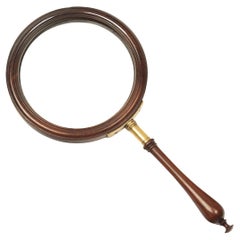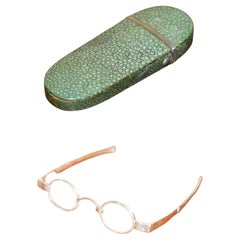Cary, London Aviation Objects
to
1
1
1
1
1
1
1
1
1
1
1
1
11
4
3
3
Creator: Cary, London
Rare George III Celestial Pocket Globe by Cary, London
By Cary
Located in Oxfordshire, United Kingdom
A fine and rare 3" celestial pocket globe by G & W Cary, Strand, London circa 1791, housed in its original sharkskin case.
A companion globe to terrestrial globes of this type we...
Category
Late 18th Century English George III Antique Cary, London Aviation Objects
Materials
Plaster
Related Items
George III Gallery Magnifying Glass
Located in Lymington, Hampshire
A George III gallery magnifying glass, the circular glass within a mahogany frame, the baluster handle screwing into a brass bracket in the rim, the handle with a brass collar. Engli...
Category
19th Century English George III Antique Cary, London Aviation Objects
Materials
Mahogany
RARE ANTiQUE GEORGE III SHAGREEN GLASSES SPECTACLES CASE AND FOLDING GLASSES
Located in West Sussex, Pulborough
Royal House Antiques
Royal House Antiques is delighted to offer for sale this absolutely stunning George III Shargeen & Silver Spectacles case with folding glasses...
Category
18th Century European George III Antique Cary, London Aviation Objects
Materials
Glass
H 5.12 in W 2.17 in D 0.79 in
George III Banjo Mahogany Barometer by R. Taylor, Chepstow, England c. 1820
By R. Taylow
Located in Atlanta, GA
A Four-dial Barometer/Thermometer in Mahogany, dating from the George III period, and English in origin. Signed at the base "R. Taylor Chepstow". The barometer with swan neck pedim...
Category
Early 19th Century English George III Antique Cary, London Aviation Objects
Materials
Brass
Pocket Globe by Nathaniel Hill, London 1754
Located in Milano, IT
Nathaniel Hill
Pocket globe
London, 1754
The globe is contained in its original case, which itself is covered in shark skin.
There are slight gaps in the original paint on the sphere. The case no longer closes.
The sphere measures 2.6 in (6.8 cm) in diameter whereas the case measures 2.9 in (7.4 cm) in diameter.
lb 0.24 (kg 0.11)
The globe is made up of twelve printed paper gores aligned and glued to the sphere.
In the North Pacific Ocean there is a scroll with the inscription:
A
New
terrestrial
Globe
by
Nath. Hill,
1754.
The celestial globe is depicted on the inside of the box.
On the terrestrial globe much of central and southern Africa is empty. North America bears only the name of some British colonies. It shows California as a peninsula and the northwest coast of America as "unknown parts" (Alaska is not described and is only partially delineated; it would become part of the United States in 1867). The route of Admiral Anson is traced (1740) and the trade winds are indicated by arrows. Australia, still named New Holland (the new name would be introduced in 1829), is part of the west coast. (See Van der Krogt, P., Old Globes in the Netherlands, Utrecht 1984, p. 146 and Van der Krogt, P. - Dekker, E., Globes from the Western World, London 1993, p. 115.)
Nathaniel Hill (London, news from 1746 to 1768) had impeccable professional credentials: he had done his apprenticeship with Richard Cushee, who at the time was carrying out surveying work for John Senex's Surrey map...
Category
1750s English George II Antique Cary, London Aviation Objects
Materials
Shagreen, Paper
English Pocket Globe, London, Circa 1775-1798
By Herman Moll
Located in Milano, IT
Pocket globe
London, between 1775 and 1798
Re-edition of the globe of Hermann Moll (1678-1732) dated 1719
The globe is contained in its original case, which itself is covered in shark skin.
There are slight gaps in the original paint on the sphere. The case no longer closes.
The sphere measures 2.7 in (7 cm) in diameter whereas the case measures 2.9 in (7.4 cm) in diameter.
lb 0.22 (kg 0.1)
The globe is made up of twelve printed paper gores aligned and glued to the sphere.
In the North Pacific Ocean there is a cartouche with the inscription:
A Correct
Globe
with the new
Discoveries.
The celestial globe is depicted on the inside of the box and is divided into two hemispheres with the cartouche:
A correct globe
with ye new cons
relations of Dr.
Halley & c.
It shows the ecliptic divided into the days of the zodiacal calendar and the constellations represented as animals and mythological figures.
On the globe are delineated the equinoctial line, divided by degrees and hours, the ecliptic and the meridian (passing west of Greenwich). The continents are shaded and outlined in pink, green and yellow. It shows: the Cook routes; a wind rose in the Southern Indian Ocean; Antarctica without land; Africa with Negroland (Hermann Moll is considered the first geographer to name the West African region in his 1727 map. (Encyclopaedia Britannica, ed. 1902, under "States of Central Africa"); Tartary in Central Asia; the Mogul kingdom in northern India; in North America only New England, Virginia, Carolina, Florida, Mississippi are identified; California is already a peninsula; the northwest coast of America is "unknown parts" (Alaska is not described and it is only partially delineated, it was to become part of the United States in 1867); Mexico is named "Spain"; Central South America "Amazone America". Australia (which was to be so named after 1829) is called New Holland. The route of Admiral Anson is traced (1740) and the trade winds are indicated by arrows. (See Van der Krogt, P., Old Globes in the Netherlands, Utrecht 1984, p. 146 and Van der Krogt, P. - Dekker, E., Globes from the Western World, London 1993, pp. 115.)
Elly Dekker, comparing Moll’s 1719 globe and his re-edition (of which the one described above is a sample), identifies the differences between them: the two editions are quite similar to each other, but in the "anonymous" globe, compared to the previous globe of 1719, California looks like a proper peninsula - the reports of the Spanish explorers of the region had given rise to uncertainty over whether it was connected to the mainland or not. The geographical nature of California was confirmed after the explorations of Juan Bautista de Anza (1774-1776). The routes of Dampier's journey were partially erased and the route of Captain James Cook's first voyage was superimposed on them, and the geography of Australasia was adapted accordingly, including the denomination of the Cook Strait. See Dekker, Elly, Globes at Greenwich, 1999.
An important ante quem element is represented by Tasmania: it is not separated from Australia by the Bass Strait...
Category
Late 18th Century English George III Antique Cary, London Aviation Objects
Materials
Shagreen, Paper
Antique George III Quality Mahogany Banjo Barometer
Located in Suffolk, GB
Antique George III quality mahogany banjo barometer having a quality mahogany shaped case with a swan neck pediment and satinwood stringing, circular silvered engraved dial with orig...
Category
Early 1800s English George III Antique Cary, London Aviation Objects
Materials
Mahogany
Fine Pair of Floor Globes by J & G Cary, Dated 1820 and 1833
By George & John Cary
Located in Lymington, Hampshire
A fine pair of 15 inch floor globes by J & G Cary, dated 1820 and 1833, each set into a mahogany stand with a vase shaped support and three legs centred on a compass, one with a labe...
Category
Early 19th Century English Regency Antique Cary, London Aviation Objects
Materials
Mahogany
18-inch Globe, Cary's, London, 1840
By Cary’s
Located in Milano, IT
John and William Cary
Updated by George and John Cary
Terrestrial Globe
London, 1840
lb 22 (kg 10)
Slight surface abrasions due to use. A small crack on the horizon circle.
The globe rests in its original Dutch style stand with four supporting turned wood columns.
It measures 26 in in height x 23.6 in in diameter with the diameter of the sphere measuring 18 in; 66 cm in height x 60 cm in diameter with the diameter of the sphere measuring 45.72 cm.
The 18 inch...
Category
1840s English Early Victorian Antique Cary, London Aviation Objects
Materials
Paper, Wood
George III Mahogany Banjo Barometer Edinburgh
Located in Huntington, NY
George III Mahogany Banjo Barometer By Edie & Son. Edinburgh
Alexander James Adie FRSE MWS (7 November 1775, Edinburgh – 4 December 1858, Edinburgh) was a Scottish maker of medical ...
Category
Late 18th Century English George III Antique Cary, London Aviation Objects
Materials
Brass
George III Rare Bronze Cased Chronology of the Sovereigns of England
Located in Bishop's Stortford, Hertfordshire
A rare and very interesting antique Georgian bronze medallion cased set of printed discs titled CHRONOLOGY OF THE SOVEREIGNS OF ENGLAND and believed to have been produced around 1815...
Category
1810s English George III Antique Cary, London Aviation Objects
Materials
Bronze
Antique Telescope, Large, Single Draw Refractor, Cary London, circa 1820
Located in Hele, Devon, GB
This is an antique telescope, a large single draw refractor for terrestrial or astronomical use. An English, late Georgian piece dating to circa 1820.
Perfect for bird watching, landscape appreciation, wildlife, or maritime observation. Equally suitable for observing the night sky. Supplied ready to enjoy; Fully inspected and lenses cleaned by our in-house restorer.
Larger than most presenting a clear, sharp optical performance
Tapered, original painted, primary barrel in good order
Draw tube in good order with smooth action
56mm, 2.25" objective lens
Presents a good, sharp and bright image
Engraved 'Cary, London'
Complete with lens CAP and swivel dust cover
Supplied with an London Fine oak and brass 'Captain's Stand' for display
An historic, period piece as good to use today as it was two hundred years ago.
Dimensions:
Max Drawn Length: 112cm (44''
Closed Length: 76cm (30'')
Objective Glass Diameter: 5.6cm (2.25'')
About Cary, The Stand, London
William Cary was born in 1759, the third of four brothers to George and Mary Cary. The eldest, George, was a haberdasher, John a map maker and the youngest, Francis, an engraver.
William served his apprenticeship under Jesse Ramsden, arguably one of the finest instrument makers in England, and went on to produce Fine instruments himself, working alongside his brother John. They produced telescopes, microscopes, navigation and surveying equipment, mechanical calculators...
Category
Early 19th Century English Georgian Antique Cary, London Aviation Objects
Materials
Brass
H 29.93 in W 2.21 in D 2.21 in
Antique George III Period Square Piano by Beck
Located in London, GB
Antique George III period square piano by Beck
English, 1788
Height 81cm, width 148cm, depth 52cm
This elegant instrument is a square piano, a type popul...
Category
Late 18th Century English George III Antique Cary, London Aviation Objects
Materials
Wood
Cary, London aviation objects for sale on 1stDibs.
Cary, London aviation objects are available for sale on 1stDibs.


